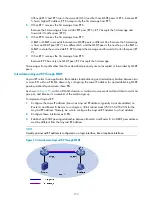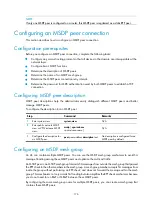
179
Step Command
Remarks
1.
Enter system view.
system-view
N/A
2.
Enter public network MSDP view or
VPN instance MSDP view.
msdp
[
vpn-instance
vpn-instance-name
]
N/A
3.
Enable encapsulation of multicast
data in SA messages.
encap-data-enable
Optional.
Disabled by default.
4.
Configure the interface address as
the RP address in SA messages.
originating-rp
interface-type
interface-number
Optional.
PIM RP address by default.
Configuring SA request messages
By default, after receiving a new join message, a router does not send an SA request message to any
MSDP peer. Instead, it waits for the next SA message from its MSDP peer. This will cause the receiver to
delay obtaining multicast source information. To enable a new receiver to get the active multicast source
information as early as possible, you can configure routers to send SA request messages to the
designated MSDP peers after receiving a join message of a new receiver.
IMPORTANT:
Before you enable the device to send SA requests, be sure to disable the SA message cache mechanism.
To configure SA message transmission and filtering:
Step Command
Remarks
1.
Enter system view.
system-view
N/A
2.
Enter public network MSDP view
or VPN instance MSDP view.
msdp
[
vpn-instance
vpn-instance-name
]
N/A
3.
Enable the device to send SA
request messages.
peer
peer-address
request-sa-enable
Optional.
Disabled by default.
4.
Configure a filtering rule for SA
request messages.
peer
peer-address
sa-request-policy
[
acl
acl-number
]
Optional.
SA request messages are not
filtered by default.
Configuring SA message filtering rules
An SA message creation rule enables the router to filter the (S, G) entries to be advertised when the router
creates an SA message. This controls the propagation of messages of multicast sources.
A filtering rule for receiving or forwarding SA messages enables the router to filter the (S, G) forwarding
entries to be advertised when the router receives or forwards an SA message. This controls the
propagation of multicast source information at SA message reception or forwarding.
A TTL threshold for multicast data packet encapsulation in SA messages controls the multicast data
packet encapsulation in SA messages and limits the propagation range of SA messages:
•
Before creating an SA message with an encapsulated multicast data packet, the router examines
the TTL value of the multicast data packet:
{
If the TTL value is less than the threshold, the router does not create an SA message.






























